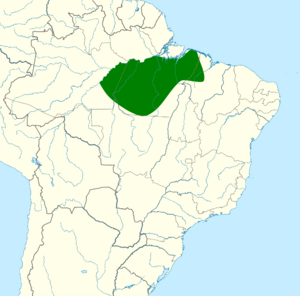Vulturine parrot facts for kids
Quick facts for kids Vulturine parrot |
|
|---|---|
| Conservation status | |
| Scientific classification | |
| Genus: |
Pyrilia
|
| Species: |
vulturina
|
 |
|
| Synonyms | |
|
Pionopsitta vulturina (Kuhl, 1820) |
|
The vulturine parrot (Pyrilia vulturina) is a special bird found only in Brazil. It belongs to the Psittacidae family, which includes all the African and New World parrots. This parrot is known for its unique bare head, which looks a bit like a vulture's!
Contents
How Scientists Classify the Vulturine Parrot
For a long time, the vulturine parrot was the only bird in its own group, called Gypopsitta. Later, scientists moved it into a different group called Pionositta. This group also included the pileated parrot.
In the early 2000s, most of these parrots, including the vulturine parrot, were moved again. They now belong to the group called Pyrilia.
The Discovery of the Bald Parrot
In 2002, something interesting happened. Scientists realized that what they thought was a young vulturine parrot was actually a completely different species! This new bird was named the bald parrot (Pyrilia aurantiocephala).
The vulturine parrot itself is monotypic. This means it does not have any different subspecies.
What Does the Vulturine Parrot Look Like?
The vulturine parrot is about 23 to 25 centimeters (9 to 10 inches) long. It weighs between 138 and 165 grams (4.9 to 5.8 ounces).
Adult Vulturine Parrot Appearance
Adult vulturine parrots have a mostly bare, black face. They have yellowish skin near their eyes and a collar of bright yellow feathers. Below this yellow collar, there is a band of black feathers.
Their upper body is green, and their shoulders have a reddish-orange color. Their chest is olive-yellow, and their belly is green with some blue edges on the feathers. Their lower legs are yellow.
The main flight feathers on their wings are black with green edges. The feathers under their wings are red. Their tail is green on top with blue tips, and green and yellow underneath.
Young Vulturine Parrot Appearance
Young vulturine parrots look a bit different. Their heads are covered in green feathers. They have yellowish feathers around their eyes and near their beak. They do not have the yellow collar that adult parrots have.
Where the Vulturine Parrot Lives
The vulturine parrot lives only in Brazil. You can find it south of the Amazon River. Its home stretches from the Madeira River in the west to near the Atlantic coast in Maranhão state.
This parrot lives in two main types of forests. It can be found in fairly dry terra firme forests. It also lives in várzea forests, which are forests that get flooded during certain seasons.
Vulturine Parrot Behavior
Scientists are still learning a lot about the vulturine parrot's daily life.
Movement and Travel
We do not know much about how the vulturine parrot moves around. It is not clear if they migrate or travel long distances.
What the Vulturine Parrot Eats
Little is known about what the vulturine parrot eats or how it finds food. However, scientists believe its bare head might be a special feature. It could help the parrot avoid getting its feathers sticky when it eats large, juicy fruits.
Reproduction and Life Cycle
Unfortunately, almost nothing is known about how the vulturine parrot reproduces. Scientists have not yet studied their breeding habits or how they raise their young.
Vocalization: The Parrot's Calls
The vulturine parrot makes different sounds. When it flies, its call sounds like a slightly nasal "tree ... trayaweet" or just "trayaweet."
When it is sitting on a branch, it makes many different noises. These can be nasal yelps or barks. It also makes more musical whistles and whining sounds. Sometimes, it makes calls that sound more like typical parrots.
Status and Conservation
The IUCN (International Union for Conservation of Nature) keeps track of how endangered animals are. They have changed their assessment for the vulturine parrot a few times. Currently, since 2021, it is listed as being of Least Concern. This means it is not considered to be in immediate danger of extinction.
Threats to the Vulturine Parrot
Even though it is "Least Concern," the vulturine parrot's population is believed to be shrinking. It lives in a large area, but its numbers are not known.
The biggest threat to this parrot is the rapid clearing of forests in the Amazon basin. Forests are being cut down to make space for cattle farms and to grow soy. This deforestation is made easier by new roads being built.
The vulturine parrot is not very common throughout the areas where it lives. There is only one protected area within its range, which is in the western part of its habitat.


